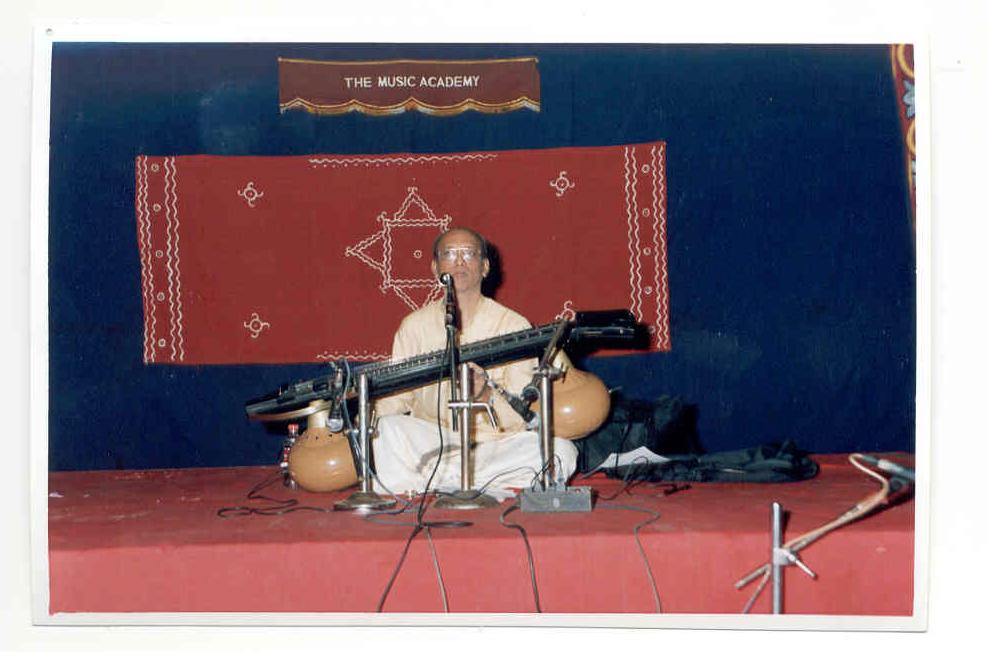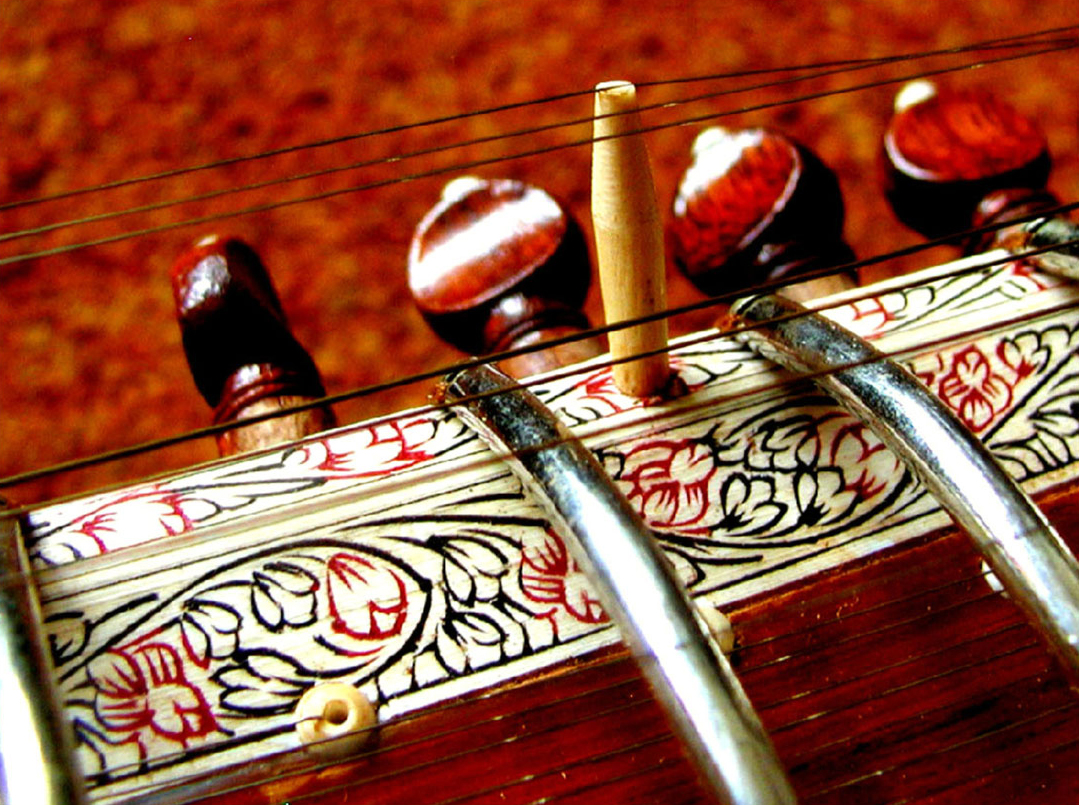|
Veena
The ''veena'', also spelled ''vina'' ( IAST: vīṇā), is any of various chordophone instruments from the Indian subcontinent. Ancient musical instruments evolved into many variations, such as lutes, zithers and arched harps.Vina: Musical Instrument Encyclopædia Britannica (2010) The many regional designs have different names such as the '' Rudra veena'', the '''', the '' Vichitra veena'' and others. The North Indian ''rudra veena'', used in |
Saraswati Veena
The Sarasvatī vīṇa (also spelled Saraswati veena) (, , , Malayalam: സരസ്വതി വീണ) is an ancient Indian plucked veena. It is named after the Hindu goddess Saraswati, who is usually depicted holding or playing the instrument. Also known as ''raghunatha veena,'' it is used mostly in Carnatic Indian classical music. There are several variations of the veena, which in its South Indian form is a member of the lute family. One who plays the veena is referred to as a ''vaiṇika''. The Saraswati veena is one of 4 major types of veena today. The others include chitra veena, vichitra veena and rudra veena. Out of these the rudra and vichitra veenas are used more often in Hindustani music, while the Saraswati veena and the chitra veena are used more frequently in the Carnatic music of South India. They can be used to play either traditional music or contemporary music. History The veena has a recorded history that dates back to approximately 1700 BCE. In anci ... [...More Info...] [...Related Items...] OR: [Wikipedia] [Google] [Baidu] |
Sarasvati Veena
The Sarasvatī vīṇa (also spelled Saraswati veena) (, , , Malayalam: സരസ്വതി വീണ) is an ancient Indian plucked veena. It is named after the Hindu goddess Saraswati, who is usually depicted holding or playing the instrument. Also known as ''raghunatha veena,'' it is used mostly in Carnatic Indian classical music. There are several variations of the veena, which in its South Indian form is a member of the lute family. One who plays the veena is referred to as a ''vaiṇika''. The Saraswati veena is one of 4 major types of veena today. The others include chitra veena, vichitra veena and rudra veena. Out of these the rudra and vichitra veenas are used more often in Hindustani music, while the Saraswati veena and the chitra veena are used more frequently in the Carnatic music of South India. They can be used to play either traditional music or contemporary music. History The veena has a recorded history that dates back to approximately 1700 BCE. In ancient ... [...More Info...] [...Related Items...] OR: [Wikipedia] [Google] [Baidu] |
Saraswati Veena
The Sarasvatī vīṇa (also spelled Saraswati veena) (, , , Malayalam: സരസ്വതി വീണ) is an ancient Indian plucked veena. It is named after the Hindu goddess Saraswati, who is usually depicted holding or playing the instrument. Also known as ''raghunatha veena,'' it is used mostly in Carnatic Indian classical music. There are several variations of the veena, which in its South Indian form is a member of the lute family. One who plays the veena is referred to as a ''vaiṇika''. The Saraswati veena is one of 4 major types of veena today. The others include chitra veena, vichitra veena and rudra veena. Out of these the rudra and vichitra veenas are used more often in Hindustani music, while the Saraswati veena and the chitra veena are used more frequently in the Carnatic music of South India. They can be used to play either traditional music or contemporary music. History The veena has a recorded history that dates back to approximately 1700 BCE. In anci ... [...More Info...] [...Related Items...] OR: [Wikipedia] [Google] [Baidu] |
Rudra Veena
The ''rudra veena'' () (also spelled ''rudraveena'' or ''rudra vīnā'') — also called the ''bīn'' in North India — is a large plucked string instrument used in Hindustani music, especially dhrupad. It is one of the major types of '' veena'' played in Indian classical music, notable for its deep bass resonance. Oral tradition ascribes the instrument to Shiva, the principal deity within Hinduism. The rudra veena is seen in temple architecture predating the Mughals. It is also mentioned in court records as early as the reign of Zain-ul Abidin (1418–1470), and attained particular importance among Mughal court musicians. Before Independence, rudra veena players, as dhrupad practitioners, were supported by the princely states; after Independence and the political integration of India, this traditional patronage system ended. With the end of this traditional support, dhrupad's popularity in India declined, as did the popularity of the rudra veena. However, in recent year ... [...More Info...] [...Related Items...] OR: [Wikipedia] [Google] [Baidu] |
Ancient Veena
The ancient veena is an early Indian arched harp, not to be confused with the modern Indian veena which is a type of lute or stick zither. Names of specific forms of the arched harp include the ''chitra vīṇā'' with seven strings, the ''vipanchi vīṇā'' with nine strings and the ''mattakokila vīṇā'' a harp or possibly board zither with 21 strings. The instrument is attested on a gold coin of the Gupta Empire from the mid-300s CE. The instrument was also illustrated in the oldest known Saraswati-like relief carvings, from Buddhist archaeological sites dated to 200 BCE, where she holds a harp-style veena. Generic meaning of veena The Sanskrit word ''veena'' (वीणा ''vīṇā'') which is attested already in the Rigveda has designated in the course of Indian history a variety of instruments of various types, as it is a generic term for all kinds of string instruments, just as the Tamil language, Tamil word ''yazh'' (யாழ் ''yaaḻ''). In the last centuries a ... [...More Info...] [...Related Items...] OR: [Wikipedia] [Google] [Baidu] |
Vichitra Veena
The ''vichitra veena'' () is a stick zither, a plucked string instrument used in Hindustani music. Similar to the Carnatic '' gottuvadhyam'' (chitra vina) it has no frets and is played with a slide. The structure The Vichitra Veena is the modern form of ancient Ekatantri Veena. It is made of a broad, fretless, horizontal arm or crossbar (''dand'') around three feet long and six inches wide, with two large resonating gourds (''tumba''), which are inlaid with ivory and attached underneath at either end. The narrow ends of the instrument are fashioned into peacock heads. The strings There are four main playing strings and five secondary strings (''chikaris''), which are played openly with the little finger for a drone effect. Underneath them are 13 sympathetic strings tuned to the notes of the appropriate raag. The veena has a five-octave range. Two plectrums ('' mizrab'') identical to those used for sitar are worn on the middle and index fingers of the right hand to pluck the ... [...More Info...] [...Related Items...] OR: [Wikipedia] [Google] [Baidu] |
Arched Harp
Arched harps is a category in the Hornbostel-Sachs classification system for musical instruments, a type of harp. The instrument may also be called bow harp. With arched harps, the neck forms a continuous arc with the body and has an open gap between the two ends of the arc (''open harps''). Arched harps are probably the most ancient form of the harp, evolving from the musical bow. The first bowed harps appeared around 3000 B.C. in Iran and Mesopotamia and then in Egypt. India may have had the instrument as early as Mesopotamia. The horizontal arched-bow from Sumeria spread west to ancient Greece, Rome and Minoan Crete and eastward to India. Like Egypt, however, India continued to develop the instrument on its own; undated artwork in caves shows a harp resembling a musical bow, with improvised resonators of different shapes and different numbers of added strings. When the angular harp replaced the arched harp about 2000 B.C. in the Middle East and spread along the Silk Road, ... [...More Info...] [...Related Items...] OR: [Wikipedia] [Google] [Baidu] |
Gottuvadhyam
The ''gottuvadyam'' is a 20 or 21-string fretless lute-style veena in Carnatic music from around the late 19th and early 20th centuries, named by Sakha Rama Rao from Tiruvidaimarudur, who was responsible for bringing it back to the concert scene. It is also known as ''chitravina'' (), ''chitra veena'', ''chitraveena'', ''chitra vina'', ''hanumad vina'' and ''mahanataka vina''. Today it is played mainly in South India, though its origins can be traced back to Bharata's Natya Shastra (200 BCE-200 CE), where it is mentioned as a seven string fretless instrument. Sarangadeva (1210–47) also made a similar reference to the chitravina in his work, Sangita Ratnakara. Recent history As a ''chitravina'' it was popularised in South India by Sakha Rama Rao before his disciple Narayan Iyengar, Gottuvadyam Narayana Iyengar (1903 - 1959), who was a palace musician of the erstwhile States of Travancore and Kingdom of Mysore, Mysore took it to great heights. Iyengar's son, Chitravina Nara ... [...More Info...] [...Related Items...] OR: [Wikipedia] [Google] [Baidu] |
Chitra Veena
The ''gottuvadyam'' is a 20 or 21-string fretless lute-style veena in Carnatic music from around the late 19th and early 20th centuries, named by Sakha Rama Rao from Tiruvidaimarudur, who was responsible for bringing it back to the concert scene. It is also known as ''chitravina'' (), ''chitra veena'', ''chitraveena'', ''chitra vina'', ''hanumad vina'' and ''mahanataka vina''. Today it is played mainly in South India, though its origins can be traced back to Bharata's Natya Shastra (200 BCE-200 CE), where it is mentioned as a seven string fretless instrument. Sarangadeva (1210–47) also made a similar reference to the chitravina in his work, Sangita Ratnakara. Recent history As a ''chitravina'' it was popularised in South India by Sakha Rama Rao before his disciple Gottuvadyam Narayana Iyengar (1903 - 1959), who was a palace musician of the erstwhile States of Travancore and Mysore took it to great heights. Iyengar's son, Chitravina Narasimhan (b. 1941) was instrumental ... [...More Info...] [...Related Items...] OR: [Wikipedia] [Google] [Baidu] |
Sitar
The sitar ( or ; ) is a plucked stringed instrument, originating from the Indian subcontinent, used in Hindustani classical music. The instrument was invented in the 18th century, and arrived at its present form in 19th-century India. Khusrau Khan, an 18th-century figure of the Mughal Empire has been identified by modern scholarship as the inventor of the sitar. According to most historians, he developed the sitar from the setar, an Iranian instrument of Abbasid or Safavid origin. Used widely throughout the Indian subcontinent, the sitar became popularly known in the wider world through the works of Ravi Shankar, beginning in the late 1950s and early 1960s. The advent of Psychedelia, psychedelic culture during the mid-to-late 1960s set a trend for the use of the sitar in popular music, sitar in Western popular music, with the instrument appearing on tracks by bands such as the Beatles, the Rolling Stones, Metallica and many others. Etymology The word ''sitar'' is derived from t ... [...More Info...] [...Related Items...] OR: [Wikipedia] [Google] [Baidu] |
Surbahar
''Surbahar'' (; ) sometimes known as bass sitar, is a plucked string instrument used in the Hindustani classical music of the Indian subcontinent. It is closely related to the sitar, but has a lower pitch. Depending on the instrument's size, it is usually pitched two to five whole steps below the standard sitar. Overview The surbahar is over 130 cm (51 inches). It uses a dried gourd as a resonator, and has a neck with very wide frets, which allow a glissando or "meend" of as much as an octave on the same fret through the method of pulling. The neck is made out of '' toona'', or mahogany wood. It has 3-4 rhythm strings (''chikari''), four playing strings (the broadest 1 mm), and 10 to 11 sympathetic strings. There are two bridges; the playable strings pass over the greater bridge, which is connected to the tabli with small legs, which are glued in place. The sympathetic strings pass over the smaller bridge which is directly glued on the tabli. The bridges have a ... [...More Info...] [...Related Items...] OR: [Wikipedia] [Google] [Baidu] |







